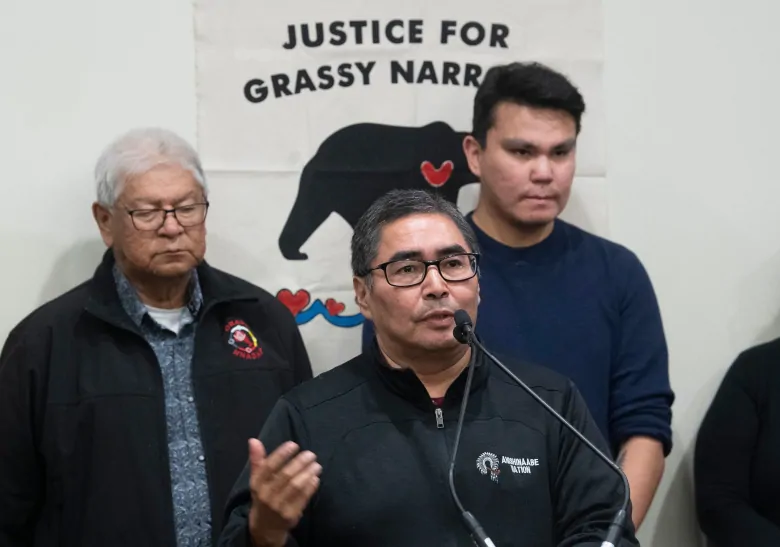Indigenous pandemic needs grow as federal funds prepare to flow

Gloves, masks and sanitizer are hard to come by in Grassy Narrows First Nation, according to Chief Rudy Turtle.
He said store shelves 88 kilometres southwest in Kenora, Ont., are running bare.
While he worries about people getting enough food to eat — not to mention toilet paper — Turtle said his most pressing fear is harder to quantify: the risk of someone introducing COVID-19 into his community of more than 1,000.
“We’re doing our best to control it, but it’s really tough,” Turtle said. “People should stay away from Grassy if they don’t have to come here.”
No one in Grassy Narrows is sick, according to Turtle. But five people in Kahnawake, on the south shore of the Saint Lawrence River across from Montreal, have tested positive for COVID-19 — the highest number of cases reported in an Indigenous community to date.
“It is certainly concerning,” said Lloyd Phillips, commissioner of public safety for the Mohawk Council of Kahnawake.
“As long as we slow the rate of transmission in our community to a manageable level and get the help to people who need it, we’ll get through this.”
The federal government has committed hundreds of millions of dollars for Indigenous communities to deal with COVID-19. Today, Indigenous Services Minister Marc Miller revealed how the funding is going to be divided.
‘A good first start’
Miller announced that the $305 million Indigenous Community Support Fund will give $215 million to First Nations, $45 million to Inuit and $30 million to Métis.
The remaining $15 million will go to Indigenous organizations that support those who live away from their communities, said Miller.
Each First Nation will get a base amount, which will be adjusted according to population, remoteness and community well-being, said Miller.
“I think it’s a good first start,” Phillips said.
“The longer this pandemic continues … they may have to review what’s going out to communities because there may be a need for a second injection of funds.”
Kahnawake, which has an on-reserve population of 7,917, is not waiting for the money to come.
The community already has set aside $9 million for workers and businesses affected by the pandemic to use before federal dollars start to flow.
All Indigenous communities can apply for funding from a separate $100 million envelope to update or create pandemic plans, get out public health messages and deal with short-term needs, according to Indigenous Services Canada.
The funding committed by the federal government can be used to purchase portable shelters from regional suppliers for screening, assessment, isolation and accommodation of additional health service providers, says the department.
In a statement sent to CBC News, a spokesperson for Indigenous Services Canada said the department has so far sent two mobile shelters to the Island Lake region in northern Manitoba and has received requests for the structures from communities in northern Saskatchewan.
“Communities are prioritized especially when there is a dependency on winter roads,” wrote Rola Tfaili.
More money needed
But the money won’t be enough for all 634 First Nations, said Assembly of First Nations Manitoba Regional Chief Kevin Hart.
He said $215 million will barely meet the needs of Canada’s 96 remote First Nations, and Hart wants the military to be on standby to help if necessary.
“If First Nations ask for resources and put forward costs … there should be no delay,” Hart said.
“If we have a crisis that hits a community of, let’s say 1,000 people … you’re looking at possibly up to 300 people becoming victims of COVID-19 in a First Nation because of overcrowding.”

The head of the national organization representing Inuit said it’s responding to needs on a daily basis and it’s not clear how much pandemic response will eventually cost.
“It remains to be seen how far that will take us and how much relief that will provide in our communities,” said Natan Obed, president of the Inuit Tapiriit Kanatami.
“The needs are going to be great, especially in relation to those who have been laid off. The cost of living in our homeland is two to three times the Canadian average, depending upon which community you live in, so there is going to be significant need in relation to the COVID-19 response in our communities.”
The $45 million allocated to the Inuit will be transferred directly to the four Inuit land claim regions, which will impose terms and conditions on the funds, said Obed.

Miller promised “maximum flexibility” with the dollars to help address local needs, adding that this investment is just the beginning.
“This is only one of the financial measures that we are contemplating for First Nations, Inuit and Métis,” he said.
“We know that more support will be needed and we will be there to make sure no Indigenous community is left behind. Our government is here to support you during this time.”
Vice-President of the Métis National Council David Chartrand said he is “very pleased” by the federal government’s contribution, and plans to give some of the money to friendship centres and issue $10,000 cheques to Winnipeg homeless shelters.
“The Métis government will take the lead in giving out resources to assist,” Chartrand said.
“That’s to share with all people, not just Métis.”





